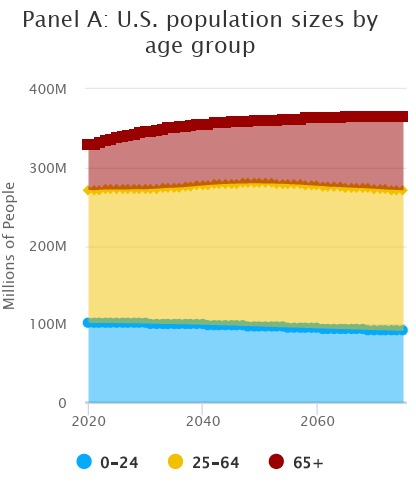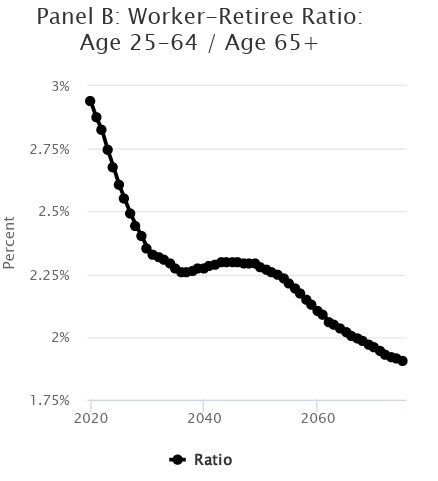Followers know that I don’t write much about politics, staying pretty straight-forward on health policy and economics topics. A little diversion occurs today, but honestly, not much. We are after all, in an election cycle and thematically (the title), demographics will be center stage but likely, for the wrong reasons.
As I watch the election cycle start to warm, I’m puzzled by the lack of discussion/debate around some serious, fundamental health policy and economic issues that are gigantic in nature. These are the proverbial elephants in the room, but politicians seemingly want to ignore their presence. Sooner or later, it must get difficult to navigate all the elephant poop that elephants make.
To the point: As a society, we have an entitlement problem that is growing out of control, and it is uniquely tied to a problem present in most first world countries…a population shift. In January, I wrote about the impacts of an aging demographic. That post is here: https://rhislop3.com/2024/01/04/__trashed/
The big entitlements of Social Security and Medicare and Medicaid consume the largest portions of the U.S. government budget and huge amounts of GDP. The health spending within the Department of Health and Human Services (25%) combined with Social Security (23%), consume almost half of all government spending. With interest on the debt (which increases by $1 trillion every 100 days), 60% of government dollars are consumed. Today, interest and defense spending are roughly equivalent. https://fiscaldata.treasury.gov/americas-finance-guide/federal-spending/
A recent report from the Penn Wharton Budget Model highlights how the aging, declining overall population numbers present significant challenges from a political policy perspective. The full report is here: US+Demographic+Projections_With+and+Without+Immigration
The primary observations from the report are,
- Recent declines in the total fertility rate have pushed it below the population replacement level of 2.1 percent per woman. The Penn Wharton Budget Model (PWBM) microsimulation projects the TFR to remain below this level during the next few decades.
- Mortality projections suggest improvements in longevity by all groups. College educated individuals enjoy the lowest mortality rates, an advantage that will persist over time.
- Persistently low fertility will make the balance of births minus deaths negative. A positive, albeit declining, population growth rate will be sustained, however, because of sustained positive net immigration.
- The shift of baby-boomer workers into retirement portends a decline in the worker-to-retiree ratio from 3.0 today to 2.0 by 2075. A faster annual immigration rate, equal to about 3.5 times the current rate, would be required to restore the ratio over the long term.
In summary, our longevity as a population is increasing though, that longevity comes with disability. Care needs increase with longevity. Our birthrate is not increasing or is actually, below the replacement value of mortality such that the current population (sans migration) is not having enough children to replace ultimately, the deaths in society and certainly, not enough to care for the aging population from a health worker perspective or from a taxpaying perspective.

Without enough workers to provide services or to pay taxes to support entitlements such as Medicare, Medicaid, and Social Security, a societal collapse of relied upon institutions (hospitals, senior living, etc.) and social supports (Social Security, Medicare) becomes inevitable.

Politically, this problem or conundrum is not new. We have been on a steady march toward this point, accelerated a bit by the COVID pandemic. A little over ten years ago, I wrote a piece about this problem (entitlements, spending, funding). It is here https://rhislop3.com/2013/10/10/debt-ceilings-government-shutdowns-and-health-policy/ Note how little has changed except the numbers are bigger and the deficit in the last four years has increased dramatically (more than $8 trillion).
In this political season, non-serious discussions will occur around a number of topics and perhaps chief among these topics is immigration. Why I say non-serious is that the U.S. does not have a coherent immigration policy and the present policies that exist are effectively, akin to an open border (not helpful). Both sides of the aisle will politic about immigration and yet, completely miss the point (noted by Penn Wharton).
Unless for some shift in ideology, citizens begin to dramatically increase the rate of children being born to birth aged women, the U.S. will need some level of immigration to maintain a working age population capable of providing needed services and generating supporting tax revenues to undergird programs like Medicare and Social Security. Or, alternatively, taxes must dramatically increase while program benefits are restructured (cut or tied to economic means testing). No other options plausibly exists and in reality, I’m not sure that an immigration-based solution alone is a permanent fix.
The point of this post today is not to lecture but to again, raise consciousness that during this political cycle, voters need to be a bit more aware that these issues are looming and getting bigger in the rear-view mirror. They cannot be outrun or deferred any longer.
Fixes are multi-layered and unfortunately, require political decisions that are bold and cooperative. Societally, we aren’t there but darn, we sure better get there quickly. News media coverage of these topics is scant to non-existent or easily dwarfed by the scandal, congressional hearing, or litigation events of the day. Talking point politics doesn’t get the core issues addressed. Look at Japan, Germany, the U.K. and France for a harbinger on what happens next…they are about five years ahead of us without addressing these issues.
Yet this week, or certainly early next, I will dissect the Biden budget proposal and the recent stop-gap spending bill passed by the House and the Senate. Anyone interested in the budget proposal (that won’t go anywhere in an election year), can visit the OMB site here: President’s Budget | OMB | The White House